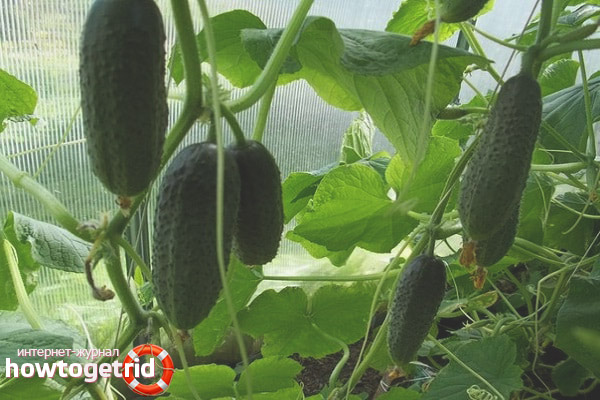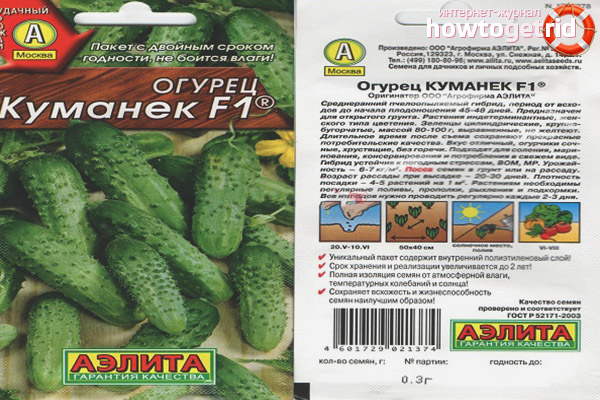The content of the article
Today, the farmers market offers many seeds of various varieties of cucumbers. In order to choose an option that meets all the requirements of a gardener, you need to try more than one type of cucumber in search of a suitable one. Among the best species is the Kumanek f1 variety.
Grade description
Kumanek F1 is the result of the work of Russian breeders. The variety is bee pollinated, therefore suitable for planting on open ground. Adapted to the conditions of heat and drought, it is best grown in the south and in the center of Russia, tolerates cloudy weather and rains in the Volga-Vyatka region.
Since the hybrid needs to be pollinated by bees, it is recommended to plant in warm regions in open areas. Often, gardeners plant different types of flowers next to these cucumbers. This allows you to attract a large number of insects.
The variety is characterized by an average bush height not exceeding 1.7 m in length, with many branches intertwining. The leaves of the plant are dark green, with a slightly rough surface. The formation of ovaries occurs according to the type of bundles, with the possibility of the formation of several fruits in one bundle.
Description of the fetus
The following parameters are characteristic for the fruits of cucumber Kumanek:
- Cylindrical shape.
- Length after ripening - up to 15 cm.
- Weight - up to 100 gr.
- The peel is dark green, tuberous surface (with the inclusion of white patches).
- Possible white stripes on the peel.
It should also be noted the high palatability of the fruit. Cucumbers are sweet; there is no smack of bitterness. The pulp of this cucumber is dense, lacking voids.
The hybrid is universal in use. It can be used to make spins for the winter, or fresh in the form, suitable for adding to salads. The conservation method allows to reveal the taste of this cucumber to a greater extent.
Advantages of the variety and its disadvantages
Kumanek cucumbers have many advantages, which include the following qualities:
- High resistance to diseases, especially to powdery mildew.
- Sweet flesh without taste of bitterness.
- Good tolerance to the process of bush formation.
- Versatility when eaten.
- Good commercial qualities and external characteristics.
The disadvantages that are inherent in the hybrid, it is necessary to include the loss of the original form with a shelf life of more than a week.
Growing process
- The first step is to treat the seeds. Most often, treatment is performed using drugs designed to stimulate growth and disinfection. In addition, it is recommended to harden the seeds, which contributes to the possibility of the formation of a strong stem.
- Before planting in open ground, it is necessary to germinate the seeds. The procedure is as follows: the seeds must be placed in a moistened pre-rag. For 3 days they are in this tissue, after which the planting process is performed. Seeds that have not yet sprouted should not be used for planting.
- Planting should be done after the soil is properly warmed up, that is, at the end of the winter season. The optimum temperature will be one that exceeds + 16C. Particular attention should be given to areas that are selected for planting, they should have good access to the light of sunlight.Due to this, the first seedlings will be obtained faster, and the process of forming a bush will also accelerate.
- When making a planting, keep a distance between the holes of 50 cm. Planting seeds and seedlings is carried out to a depth equal to or greater than 2 cm.
How to care for Kumanek cucumbers

It is necessary to water only in the evening, in order to preserve the moisture obtained in the root system. In addition, the water used for this should be at room temperature. In order to attract pollinating insects and bees, it is recommended to plant a variety of flowers near cucumbers.
We must not forget about soil fertilization, since cucumbers of this species remain resistant to temperature differences only when grown in soil saturated with nutrients. Top dressing must be done in a timely manner. Organic fertilizers (humus and wood ash) are suitable for this, which should be alternated with substances of mineral origin (nitrogen and potassium compounds).
It is also required to pay due attention to the constant weeding of beds and the removal of weeds. Loosening the soil will also be beneficial. All this favorably affects the plant and allows it to receive the necessary amount of nutrients and moisture.
Possible diseases and pest control
For preventive purposes, experts recommend the use of substances with a high concentration of copper. Some farmers advise using solutions of aloe vera and manganese to prevent and protect the plant from harmful insects. By treating with such products, the risk of damage to the hybrid by pests such as aphids and whiteflies can be avoided.
Kumanek cucumbers are characterized by a pleasant taste, which is especially revealed during conservation, good productivity, and the culture is not demanding to care due to the rare need for watering. Moreover, the hybrid is able to tolerate dry periods. This variety will be an excellent choice for gardeners who do not often have the opportunity to visit the site.
Video: how often and how much to water cucumbers?











Submit